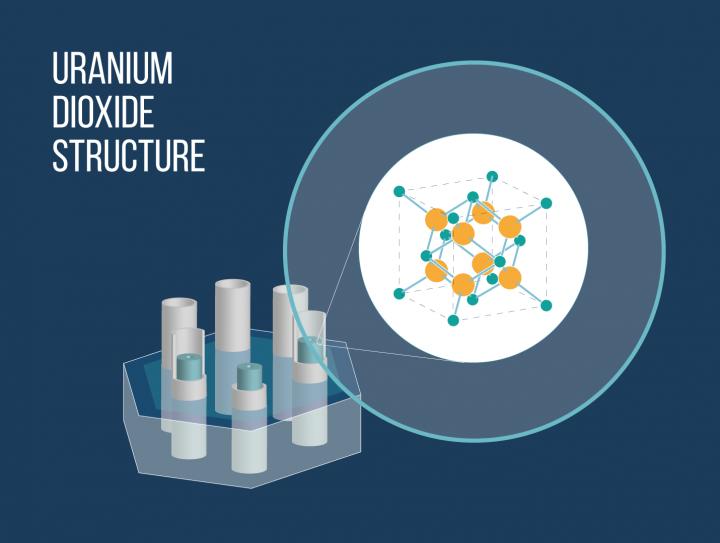Researchers model the way into a nuclear future

Uranium dioxide structure is illustrated. Credit: MIPT Press Office
Physicists from MIPT and the Joint Institute for High Temperatures of the Russian Academy of Sciences described the mobility of line defects, or dislocations, in uranium dioxide. This will enable future predictions of nuclear fuel behavior under operating conditions. The research findings were published in the International Journal of Plasticity.
Nuclear fuel has an immense potential, as it is one of the most energy dense resources available: a single uranium dioxide fuel pellet weighing no more than a few grams releases the same amount of energy within the reactor core that is produced by burning several hundred kilograms of anthracite coal or oil.
When a nuclear reactor is in operation, the fuel in the pellets undergoes extremely complex transformations caused by both temperature and radiation. Because the underlying mechanisms of these transformations are not yet fully understood, we are still unable to realize the complete potential of nuclear fuel and reduce the risk of accidents to a minimum.
The mechanical properties of fuel pellets, which play an important part in nuclear engineering, are determined by the motion of and interaction between dislocations. Dislocation mobility in uranium dioxide at high temperatures and under stress had never been studied in detail.
That is before the recent research into dislocation dynamics carried out by Artem Lunev, Alexey Kuksin, and Sergey Starikov. In their paper, the scientists provide data of a simulation of dislocation behavior in uranium dioxide, which is one of the most widespread compounds used as nuclear fuel on power plants across the globe.
To be used as nuclear fuel, uranium dioxide is formed into ceramic pellets that are sintered at a high temperature. This material has a very high melting point, is resistant to radiation-induced growth, and does not experience phase transitions within a broad temperature range. Theoretically, a solid body has a regular, ordered structure (crystalline structure), and there is a certain designated position for each atom to be at. In reality, perfect crystals do not exist, because some atoms or groups of atoms are always out of place, altering the ideal arrangement.
In other words, there are defects (imperfections) in an actual crystal. They come in several types, viz., point defects, line defects (dislocations), planar defects, and bulk defects. Defects can move within the crystal, and the nature of their motion depends on external factors. Dislocation dynamics are known to determine fuel properties relevant to nuclear engineering (plasticity, fission fragments diffusion).
In their study, the scientists from MIPT and the Joint Institute for High Temperatures used computational methods to develop a model of an isolated dislocation in a perfect uranium dioxide crystal. They calculated the varying dislocation velocity as a function of temperature and the external forces affecting the crystal.
The researchers analyzed simulation results within the framework of statistical physics and obtained a model that describes the behavior of dislocations in a broad temperature range under shear stress of various magnitudes. This model enables the calculation of dislocation velocity based on the known temperature and stress parameters.
The model proposed by the Russian scientists could soon be used to simulate more complex systems and study the macroscopic processes occurring in fuel pellets under operating conditions.
“This is a major advance toward being able to describe processes as complex as nuclear fuel swelling and embrittlement during operation by means of computer simulations alone,” says Sergey Starikov, a coauthor of the study, an associate professor at MIPT, and a senior researcher at the Joint Institute for High Temperatures.
Computer modeling enables scientists to trace individual fuel atoms and calculate their velocities and forces affecting them, along with other parameters. This allows systems of various complex configurations to be simulated and studied. Computer modeling is widely used in situations where performing an experiment is rather problematic. Research into nuclear fuel behavior is precisely one of those areas. Such large-scale calculations rely on modern supercomputers, as massive computing power is required to find the forces affecting individual atoms at each moment in time.
Media Contact
All latest news from the category: Physics and Astronomy
This area deals with the fundamental laws and building blocks of nature and how they interact, the properties and the behavior of matter, and research into space and time and their structures.
innovations-report provides in-depth reports and articles on subjects such as astrophysics, laser technologies, nuclear, quantum, particle and solid-state physics, nanotechnologies, planetary research and findings (Mars, Venus) and developments related to the Hubble Telescope.
Newest articles

A new puzzle piece for string theory research
Dr. Ksenia Fedosova from the Cluster of Excellence Mathematics Münster, along with an international research team, has proven a conjecture in string theory that physicists had proposed regarding certain equations….

Climate change can cause stress in herring larvae
The occurrence of multiple stressors undermines the acclimatisation strategies of juvenile herring: If larvae are exposed to several stress factors at the same time, their ability to respond to these…

Making high-yielding rice affordable and sustainable
Plant biologists show how two genes work together to trigger embryo formation in rice. Rice is a staple food crop for more than half the world’s population, but most farmers…



